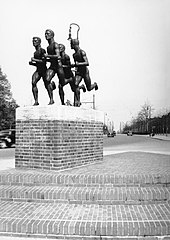Pichelsberg
Pichelsberg is a local situation of Berlin hamlet Westend in Charlottenburg-Wilmersdorf . It is located in the profiled hilly landscape of the same name (also called Pichelsberg ), which was shaped by the Ice Age and is located on the western edge of the Teltow above the Havel . As with Pichelsdorf and Pichelswerder on the Spandau side, the name probably goes back to the extraction of pitch in the formerly remote forest area.
Pichelsberg is cut through by the Heerstraße , laid out at the beginning of the 20th century , which crosses the Stößensee on the western edge of Pichelsberg with the Stößenseebrücke , a bulge of the Havel. To the south of Heerstraße, country houses were built around 1930 along the Am Rupenhorn road. Near Scholzplatz, named after the last mayor of the formerly independent city of Charlottenburg , there is the Jewish cemetery in Heerstrasse and the British military cemetery , as well as a radio mast for the RBB and the British settlement with buildings by Alfred Gellhorn . To the north of Heerstrasse, a high-rise housing estate was built on Angerburger Allee between 1968 and 1970 according to plans by Senate Building Director Werner Düttmann .
history

Am Postfenn / Havelchaussee was an early Slavic settlement in the area, which was abandoned around 1250. Excavations and the field name Dorfstättengrund prove the settlement. Nearby field names indicate that the 62 meter high Pichelsberg, the highest point in the area , could have been called Wirchow (from Slav . Virch : hill). The forester's lodge, built around 1750, was followed by a pavilion built by Count Kameke above the Havel in 1798. After a long and eventful history, the pavilion was demolished in 1964.
Restaurants
Around the middle of the 19th century, there was a lot of excursion traffic to the scenic area, which from the height allowed attractive views over the Havel, which spreads like a lake. After a bar at the forester's house was initially set up, numerous restaurants gradually settled in Pichelsberg, as well as on the opposite Pichelswerder, initially the Reichsgarten , which opened in 1873, halfway up in the acute angle between Angerburger Allee and Havelchaussee and the Kaisergarten on the banks of the Havel. The last time Conrad Herold built the Pichelsberg Seeschloss north of the Kaisergarten was in 1898 . On some weekends there was a lot of activity in Pichelsberg. The Seeschloss Pichelsberg alone had a hall for a thousand guests.
traffic
At first, Pichelsberg was not easy to reach for day trippers. From the “ Spandauer Bock ”, which can be reached by horse-drawn tram, and the Grunewald train station , you walked over an hour to the Pichelsberge. The first bus connection was not established until Heerstraße was built. On September 5, 1911, the Pichelsberg station was opened on the Spandau suburban railway. In 1928 the line was electrified for the Berlin S-Bahn . After the S-Bahn strike in 1980, the line and the station were shut down and only reopened on January 16, 1998.
Germania planning
At the end of the 1930s, Hitler , together with his master builder Albert Speer , planned a university town on both sides of Heerstrasse as part of the planned expansion of Berlin into the “ World Capital Germania ” that would have stretched over almost the entire area of Pichelsberg. With the exception of a few beginnings, for example the defense technology faculty under today 's Teufelsberg , the oversized plans fell victim to the Second World War .
Web links
- Pichelsberg in Charlottenburger Bezirkslexikon
- Timeline Pichelsberg
- Pichelsberge and Breite Berg / The Grunewald in the mirror of time
Individual evidence
- ↑ Angerburger Allee residential complex and business center
- ↑ Geraldine Saherwala (ed.): Citizen, farmer, nobleman. Berlin in the Middle Ages . Verlag Nicolai, Berlin 1987, ISBN 3-87584-198-0 .
- ^ Hans J. Reichhardt, Wolfgang Schächen: From Berlin to Germania. About the destruction of the "Reichshauptstat" by Albert Speer's redesign plans . Transit Verlag, Berlin 1998, ISBN 3-88747-127-X .
Coordinates: 52 ° 30 '37.4 " N , 13 ° 13' 37.7" E



